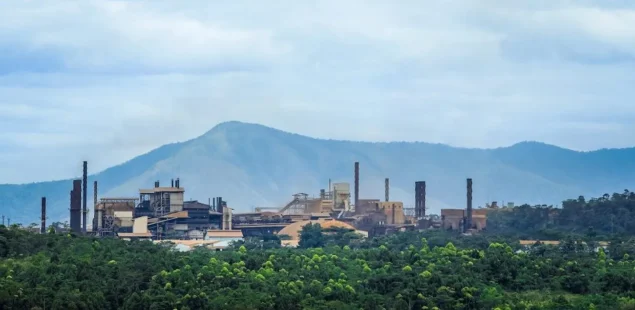
Indonesia has attracted over $80 billion ($102.5 billion) in nickel smelting investments during the past decade and now seeks to replicate this success in copper processing, where the country operates only four copper smelters compared to more than 50 nickel facilities. The Southeast Asian nation’s copper industry has secured over $9 billion in recent investments, including major facilities from PT Freeport Indonesia in East Java and PT Amman Mineral in West Nusa Tenggara, as global refined copper demand projects growth from 27 million tonnes in 2024 to 31 million tonnes by 2030.
Investment Gap Highlights Processing Potential
Indonesia ranks tenth globally in copper reserves with 220.3 million tonnes but sixteenth in refined copper production, creating what Petromindo research describes as substantial investment opportunities in copper refining infrastructure. The country lags behind nations without copper reserves, including Japan, South Korea, and Germany, in processing capacity relative to resource endowment. This disparity reflects Indonesia’s historical focus on raw material exports rather than value-added processing until recent government policies mandated domestic refining.
Current copper processing capabilities concentrate on basic products including copper anodes for decorative applications and copper cathodes for battery manufacturing, while advanced products like sintered copper components for automotive electrical systems and granulated copper powder for electronics remain undeveloped. The processing gap represents opportunities for investors seeking exposure to Indonesia’s expanding industrial base and growing domestic demand from electrification initiatives.
Electric Vehicle Growth Drives Copper Demand
Indonesia’s electric vehicle market demonstrates accelerating adoption, with four-wheeled EV sales tripling to 16,770 units in the first quarter of 2025 compared to the same period in 2024. Government projections target annual sales of 195,000 four-wheeled EVs and 5 million two-wheeled EVs by 2030, requiring approximately 36,185 tonnes of copper annually based on consumption rates of 83 kilograms per four-wheeled vehicle and 4 kilograms per two-wheeled unit.
The country’s aggressive infrastructure development plans include constructing 47,758 kilometers of new transmission cables to create a unified power grid across major islands, while renewable energy capacity expansion targets five-fold acceleration through 2029 and eleven-fold growth from 2030-2034. These initiatives require substantial copper inputs for electrical infrastructure, supporting domestic demand growth beyond export markets.
Major Smelting Projects Reshape Production Capacity
PT Freeport Indonesia’s $3.7 billion copper refining facility in Gresik, East Java, resumed operations in May 2025 following fire-related repairs, currently operating at 40% capacity with plans to reach full production by December 2025. The facility processes 1.7 million tonnes of copper concentrate annually, producing 650,000 tonnes of copper cathode, with the company targeting 415,000 tonnes of output in 2025.
PT Amman Mineral commenced copper cathode production in March 2025 at its $1.4 billion facility in West Sumbawa, processing 900,000 tonnes of copper concentrate into 220,000 tonnes of copper cathode annually. The company plans capacity doubling through expansion and construction of a 450-megawatt power plant to support increased operations, reflecting confidence in long-term copper market fundamentals.
Chinese Investment Dominance Extends Beyond Nickel
Chinese companies control approximately 75% of Indonesia’s nickel refining capacity through entities including Tsingshan Holding Group and Jiangsu Delong Nickel Industry, which invested over $10 billion since 2015. This dominance extends to battery manufacturing, with CATL constructing a 15-gigawatt capacity facility in West Java scheduled for completion in 2026, capable of producing batteries for 250,000 electric vehicles annually.
The concentration of Chinese investment raises concerns about Indonesia’s ability to independently control pricing and supply decisions, according to security analysis from C4ADS. However, the investment influx has accelerated Indonesia’s industrial development and provided access to advanced processing technologies previously unavailable domestically.
Production Targets Position Indonesia Among Global Leaders
Indonesia projects copper cathode production capacity reaching 1.1 million tonnes annually in the near term, elevating the country’s global ranking to fifth from sixth position. Long-term projections indicate potential capacity of 1.2 million tonnes once all planned facilities achieve full operation, surpassing Russia’s 2023 production levels and establishing Indonesia among the world’s top copper producers.
The production expansion occurs alongside growing domestic consumption, with current demand estimated at 350,000 tonnes annually. Government renewable energy and electric vehicle targets could increase domestic copper requirements by 59,400 tonnes by 2030, while substantial export capacity remains available for international markets.
Company Background and Market Context
PT Freeport Indonesia operates as a majority government-owned entity with significant minority participation from Arizona-based Freeport-McMoRan, controlling the massive Grasberg mine in Papua province. The company represents Indonesia’s largest copper producer and has expanded into downstream processing following government mandates for domestic value addition.
PT Amman Mineral operates as a private company with partial ownership by Indonesian tycoon Anthoni Salim, focusing on integrated mining and processing operations in West Nusa Tenggara. The company’s Batu Hijau mine provides feedstock for its new smelting facility while developing the Elang project for future expansion.
Copper serves as an essential industrial metal with the second-highest electrical conductivity after silver, making it indispensable for electrical wiring, motors, generators, and renewable energy infrastructure. Global demand growth reflects accelerating electrification across transportation, power generation, and data center applications, while supply constraints from mature mining regions support investment in new processing capacity. Indonesia’s strategic position combines abundant copper reserves, government support for downstream processing, and growing domestic demand from infrastructure development and energy transition initiatives.



